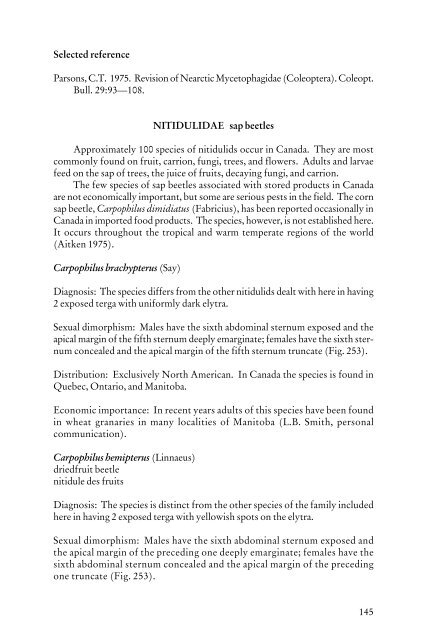Beetles Identification Guide
Beetles Identification Guide
Beetles Identification Guide
You also want an ePaper? Increase the reach of your titles
YUMPU automatically turns print PDFs into web optimized ePapers that Google loves.
Selected reference<br />
Parsons, C.T. 1975. Revision of Nearctic Mycetophagidae (Coleoptera). Coleopt.<br />
Bull. 29:93—108.<br />
NITIDULIDAE sap beetles<br />
Approximately 100 species of nitidulids occur in Canada. They are most<br />
commonly found on fruit, carrion, fungi, trees, and flowers. Adults and larvae<br />
feed on the sap of trees, the juice of fruits, decaying fungi, and carrion.<br />
The few species of sap beetles associated with stored products in Canada<br />
are not economically important, but some are serious pests in the field. The corn<br />
sap beetle, Carpophilus dimidiatus (Fabricius), has been reported occasionally in<br />
Canada in imported food products. The species, however, is not established here.<br />
It occurs throughout the tropical and warm temperate regions of the world<br />
(Aitken 1975).<br />
Carpophilus brachypterus (Say)<br />
Diagnosis: The species differs from the other nitidulids dealt with here in having<br />
2 exposed terga with uniformly dark elytra.<br />
Sexual dimorphism: Males have the sixth abdominal sternum exposed and the<br />
apical margin of the fifth sternum deeply emarginate; females have the sixth sternum<br />
concealed and the apical margin of the fifth sternum truncate (Fig. 253).<br />
Distribution: Exclusively North American. In Canada the species is found in<br />
Quebec, Ontario, and Manitoba.<br />
Economic importance: In recent years adults of this species have been found<br />
in wheat granaries in many localities of Manitoba (L.B. Smith, personal<br />
communication).<br />
Carpophilus hemipterus (Linnaeus)<br />
driedfruit beetle<br />
nitidule des fruits<br />
Diagnosis: The species is distinct from the other species of the family included<br />
here in having 2 exposed terga with yellowish spots on the elytra.<br />
Sexual dimorphism: Males have the sixth abdominal sternum exposed and<br />
the apical margin of the preceding one deeply emarginate; females have the<br />
sixth abdominal sternum concealed and the apical margin of the preceding<br />
one truncate (Fig. 253).<br />
145
















